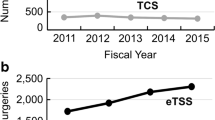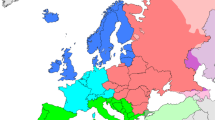Abstract
Background
Walter E. Dandy (1886–1946) was an outstanding neurosurgeon who spent his entire career at the Johns Hopkins Hospital. After graduating from medical school in 1910, he completed a research fellowship in the Hunterian laboratory with Harvey Cushing and then joined the Department of Surgery as resident, rising to the rank professor in 1931. Dandy made several contributions that helped building the neurosurgical specialty, most famously the introduction of pneumo-ventriculography to image brain lesions for which he received a Nobel prize nomination. He also performed many pituitary surgeries, although his role in this area is less known and overshadowed by that of Cushing’s.
Purpose
This retrospective cohort study was designed to unveil Dandy’s pituitary work and place it in the context of the overall pituitary surgeries performed at the Johns Hopkins Hospital.
Methods
Pituitary surgery data were obtained by screening the paper and electronic surgical pathology records of the Department of Pathology, as well as the general operating room log books of the Johns Hopkins Hospital housed in the Chesney Medical Archives.
Results
A total of 3211 pituitary surgeries associated with a pathological specimen were performed between February 1902 and July 2017 in 2847 patients. Most of the surgeries (2875 of 3211 89%) were done by 21 neurosurgeons. Dandy ranks 4th as number of surgeries, with 287 pituitary operations in 35 years of activity. He averaged 8 pituitary surgeries per year, a rate that positions him 6th among all Hopkins neurosurgeons. With the exception of his first operation done in July 1912 while Cushing was still at Hopkins, Dandy approached the pituitary gland transcranially, rather than transphenoidally. The majority of Dandy’s pituitary patients had a pathological diagnosis of pituitary adenomas, followed by craniopharyngiomas and sellar cysts. In the decades Dandy operated, pituitary surgeries represented 0.56% of the total Johns Hopkins surgeries, a percentage significantly greater (p < 0.001) than the 0.1% observed in modern days. Dandy’s pituitary clinical work was matched by important experimental studies done in the early stages of his career.
Conclusions
This study highlights the role of Dandy as an important contributor to advance our understanding of pathophysiology and treatment of pituitary diseases.


Similar content being viewed by others
References
Rizzoli HV (1987) Dandy’s contributions to the foundation of neurological surgery. Pediatr Neurosci 13:316–322
Marie P (1886) Sur deux cas d’acromégalie: hypertrophie singulière non congénitale des extrémités supérieures, inférieures, and céphalique. Rev Med Liège 6:297–333
Cope VZ (1916) The pituitary fossa and the methods of surgical approach thereto. Br J Surg 4:107–144
Caton R (1893) Notes of a case of acromegaly treated by operation. Br Med J 2:1421–1423
Horsley V (1886) Brain surgery. Br Med J 2:670–675
Horsley V (1906) On the technique of operations of the central nervous system. Br Med J 2:411–423
Krause F (1905) Hirnchirurgie (Freilegung der Hypophyse). Deutsche Klin 8:1004–1024
Cushing H (1912) The pituitary body and its disorders. Clinical states produced by siroders of the hypophysis cerebri. Philadelphia: J.B. Lippincott Company
Schmidt RF, Choudhry OJ, Takkellapati R, Eloy JA, Couldwell WT, Liu JK (2012) Hermann Schloffer and the origin of transsphenoidal pituitary surgery. Neurosurg Focus 33:E5
Cohen-Gadol AA, Liu JK, Laws ER Jr (2005) Cushing’s first case of transsphenoidal surgery: the launch of the pituitary surgery era. J Neurosurg 103:570–574
Liu JK, Cohen-Gadol AA, Laws ER Jr, Cole CD, Kan P, Couldwell WT (2005) Harvey Cushing and Oskar Hirsch: early forefathers of modern transsphenoidal surgery. J Neurosurg 103:1096–1104
Dandy Marmaduke ME (2015) Walter Dandy (1886–1946): a personal retrospective. Neurosurgery 77:501–508 (discussion 508)
Dandy Marmaduke ME. The personal side of a premier neurosurgeon. Philadelphia: Lippincott Williams & Wilkins
Campbell E, Walter E (1951) Dandy-surgeon, 1886–1946. J Neurosurg 8:249–262
Dandy WE (1910) A human embryo with seven pairs of somites measuring about 2 mm in length. Am J Anat 10:85–108
Dandy WE, Goetsch E (1911) The blood supply of the pituitary body. Am J Anat 11:137–150
Dandy WE (1913) The nerve supply to the pituitary body. Am J Anat 15:333–343
Cohen-Gadol AA, Laws ER, Spencer DD, De Salles AA (2005) The evolution of Harvey Cushing’s surgical approach to pituitary tumors from transsphenoidal to transfrontal. J Neurosurg 103:372–377
Pendleton C, Adams H, Laws ER, Quinones-Hinojosa A (2010) The elusive Minnie G.: revisiting Cushing’s case XLV, and his early attempts at improving quality of life. Pituitary 13:361–366
Pendleton C, Adams H, Mathioudakis N, Quinones-Hinojosa A (2013) Sellar door: Harvey Cushing’s entry into the pituitary gland, the unabridged Johns Hopkins experience 1896–1912. World Neurosurg 79:394–403
Pendleton C, Adams H, Salvatori R, Wand G, Quinones-Hinojosa A (2011) On the shoulders of giants: Harvey Cushing’s experience with acromegaly and gigantism at the Johns Hopkins Hospital, 1896–1912. Pituitary 14:53–60
Pendleton C, Wand G, Quinones-Hinojosa A (2010) The autopsy was conducted “Under most inauspicious circumstances:” John Turner, Harvey Cushing’s case XXXII, and his unwitting contributions to the early understanding of acromegaly. Pituitary 13:324–328
Pendleton C, Zaidi HA, Pradilla G, Cohen-Gadol AA, Quinones-Hinojosa A (2010) Harvey Cushing’s attempt at the first human pituitary transplantation. Nat Rev Endocrinol 6:48–52
Liu JK, Das K, Weiss MH, Laws ER Jr, Couldwell WT (2001) The history and evolution of transsphenoidal surgery. J Neurosurg 95:1083–1096
Dandy W, Goetsch E (1911) The blood supply of the pituitary body. Am J Anat 11:137–150
Dandy W (1913) The nerve supply to the pituitary body. Am J Anat 15:333–343
Heuer GD (1918) A new hypophysis operation. Devised by G. J. Heuer. Presented by W.E.D. in Heuer’s absence. the Johns Hopkins Medical Society. Johns Hopkins Hosp Bull 29:154–155
Dandy W (1922) An operation for the removal of large pituitary tumors. Bull Johns Hopkins Hosp 33:189
Dandy W, Reichert F (1925) Studies on experimental hypophysectomy; effect on the maintenance of life. Johns Hopkins Hosp Bull 37:1–13
Reichert F, Dandy W (1936) Polyuria and polydipsia (diabetes insipidus) and glycosuria resulting from animal experiments on the hypophysis and its environs. Bull Johns Hopkins Hosp 58:418
Dandy W (1940) Section of the human hypophysial stalk: its relation to diabetes insipidus and hypophysial functions. J Am Med Assoc 114:312–314
Dandy W, Leet Reichert F (1938) Studies on experimental hypophysectomy in dogs; somatic, mental and glandular effects. Bull Johns Hopkins Hosp 62:122–155
Rizzoli HV, Walter E (1985) Dandy: an historical perspective. Clin Neurosurg 32:3–22
Dandy W, Blackfan K (1913) An experimental and clinical study of internal hydrocephalus. J Am Med Assoc 61:2216–2217
Dandy W, Blackfan K (1914) Internal hydrocephalus: an experimental, clinical and pathological study. Am J Dis Child 8:406–482
Dandy W (1918) Ventriculography following the injection of air into the cerebral ventricles. Ann Surg 68:5–11
Hsu W, Li KW, Bookland M, Jallo GI (2009) Keyhole to the brain: Walter Dandy and neuroendoscopy. J Neurosurg Pediatr 3:439–442
Brewster R, Bi WL, Smith TR, Gormley WB, Dunn IF, Laws ER Jr (2015) The neurosurgeon as baseball fan and inventor: Walter Dandy and the batter’s helmet. Neurosurg Focus 39:E9
Sherman IJ, Kretzer RM, Tamargo RJ (2006) Personal recollections of Walter E. Dandy and his brain team. J Neurosurg 105:487–493
Rizzoli HV (1985) Dandy’s brain team. Clin Neurosurg 32:23–37
Dandy WE (1934) Removal of cerebellopontile (acoustic) tumors through a unilateral approach. Arch Surg 29:337–344
Dandy WE (1929) An operation for the cure of tic douloureux: partial section of the sensory root at the pons. Arch Surg 18:687–734
Dandy WE (1928) Ménière disease: its diagnosis and a method of treatment. Arch Surg 16:1127–1152
Dandy W (1942) Recent advances in the diagnosis and treatment of ruptured intervertebral disks. Ann Surg 115:514–520
Acknowledgements
The work was supported by NIH Grant RO1 CA-194042 to P.C. The authors are grateful to Ms. Marjorie Kehoe and Phoebe Evans Letocha of the Alan Mason Chesney Medical Archives for their assistance with the study.
Author information
Authors and Affiliations
Corresponding author
Ethics declarations
Conflict of interest
The authors declare that they have no conflict of interest.
Ethical approval
This article does not contain any studies with human participants or animals performed by any of the authors.
Electronic supplementary material
Below is the link to the electronic supplementary material.
Rights and permissions
About this article
Cite this article
Corsello, A., Di Dalmazi, G., Pani, F. et al. Walter E. Dandy: his contributions to pituitary surgery in the context of the overall Johns Hopkins Hospital experience. Pituitary 20, 683–691 (2017). https://doi.org/10.1007/s11102-017-0834-6
Published:
Issue Date:
DOI: https://doi.org/10.1007/s11102-017-0834-6




